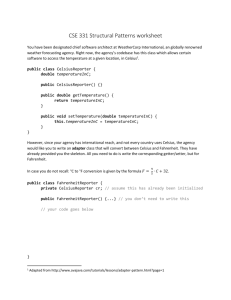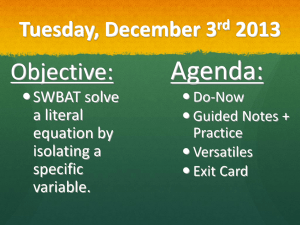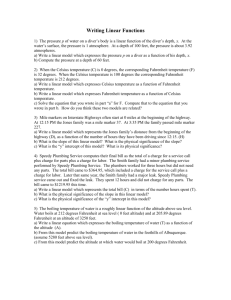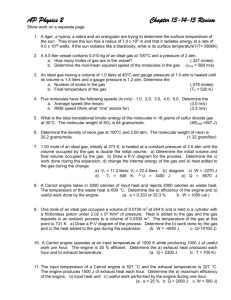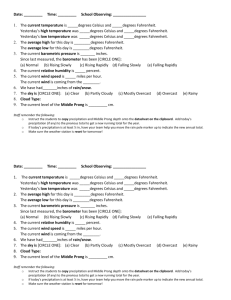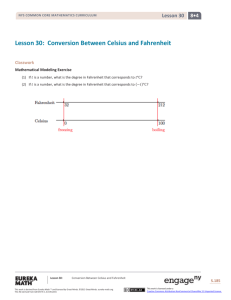OLL#9: Temperature in Thermal Systems
advertisement
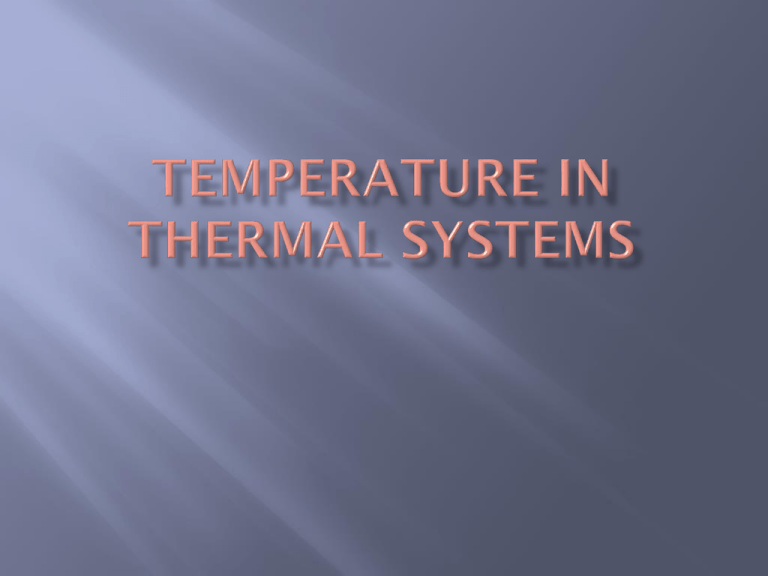
Thermal systems are designed to move heat energy from warmer regions to cooler regions Usually to help remove excessive heat (ex. radiator of car) Temperature difference (∆T) is the prime mover/force-like quantity in thermal systems similar to voltage in electrical systems and force in mechanical systems. Heat energy always flow from high to low heat energy regions i.e. system tries to reach equilibrium so that temp is the same across the entire system Temperature depends on the presence or absence of heat Measured either in Fahrenheit(F) or Celsius(C) If measuring temperature than written as °F or °C (degree symbol is written BEFORE symbol) If measuring temperature difference(change in temperature) then must write C ° or F ° (placement of ° symbol changes so it is written AFTER the symbol) Temperature is a scalar quantity It is a measure of the amount of average energy that molecules in motion have The more motion, the greater the energy, the higher the temperature (cool to warm to hot) 1a. Thermometers Most common device is the liquid-in-glass thermometer Glass bulb containing capillary tube filled with liquid (most commonly alcohol…or mercury) As temp increases, fluid expands and rises up capillary tube Height of fluid is measured using scale on outer surface of glass – either Celsius(SI/metric unit) or Fahrenheit(English unit) 2a. Thermocouples Thermocouple is another type of device used to measure temperature (temperature difference) Depends on changes in electrical properties of certain metals (ex. Iron, Constantan, Chromel) when 2 of these metals are twisted together (like a twist-tie) they make a thermocouple junction A small voltage develops across the connecting joint when the other ends of the wires are at different temperatures Amount of voltage generated depends on the types of metal used and the temperature difference being measured 2a. Thermocouples cont. 2 thermocouple junctions connected together make a thermocouple thermometer WIRE A Contains 2 junctions(TR and T) connected to a Voltmeter One of the junctions is a reference junction (TR) The other junction is the measurement junction (T) When the junction of the two metals for TR and T is heated or cooled a voltage is produced that can be correlated back to the actual temperature. If temp at T is greater than at TR ,a higher positive voltage will be read by the voltmeter. A negative voltage will be read if temp at T< TR 1b. Thermometer Scales and Calibration To ensure proper measurements thermometers must first be calibrated Done using 2 reference points – boiling and freezing In Celsius: Boiling pt water = 100°C(at sea level) Freezing pt water = 0°C which means 100° Celsius degree(°) points on scale between boiling and freezing In Fahrenheit: Boiling pt of water = 212F and Freezing pt water = 32F which means 180 Fahrenheit degree points between boiling and freezing Now complete this: Student Exercises Q1-8 on pp.97-98 in workbook. YOU MUST COPY EACH QUESTION and draw the table for Q#2 and use GFS for Q#5. 1c. Converting Among Celsius and Fahrenheit Scales (absolute values) To convert from Fahrenheit to Celsius: T(°C) = 5/9[T(°F) – 32°] To convert from Celsius to Fahrenheit: T(°F) = 9/5 T(°C) + 32° PRACTICE: Now try Example “1a” on the last slide… 1d. Converting Among Celsius and Fahrenheit Scales For Temperature Difference With temp.difference you must use relationship: 1C° = 1.8F° Set up correct proportion depending on given PRACTICE: Now try Examples “1b & c” on the last slide... 1a) Outside temperature is 42°C. Use GFS to find what is the temperature in °F? b) The next day the temperature drops to 93.2 °F. Use GFS to find the temperature change/difference? c) Convert your answer from “b” to C° PRACTICE WORK: Complete Q1-6 on pg.101 in workbook using GFS. Read the examples on pp.99-100 if you need help. Note: This work must all be done by the end of class

